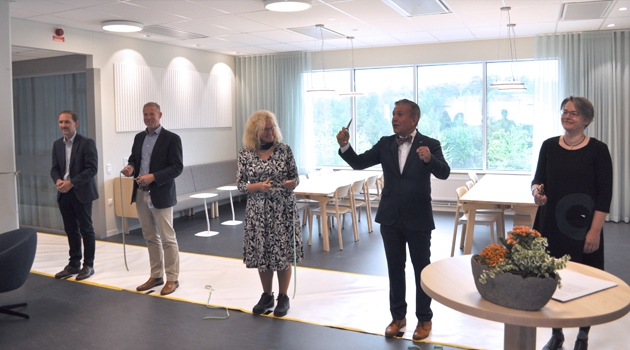After two years of construction work, it was finally time to officially open Uppsala University’s newest addition, building 9. Due to the pandemic restrictions on visitors, interested parties had to follow the opening via video link. The ceremony was held on the second floor of the new wing in the south-east corner of Ångström Laboratory. Vice-Chancellor Eva Åkesson started the proceedings by stating that Ångström Laboratory is growing and needs to make room for more researchers and students.
“Our infrastructure is crucial for attracting the best researchers, teachers, and students. We have high ambitions and want to be leaders in development, and this initiative will give us greater opportunities to contribute to a better world.”
She went on to thank all those who had contributed to the project and this addition to Uppsala University. Building 9 is part of the construction project “Nya Ångström” (New Ångström Laboratory). The new main building north of the current Ångström Laboratory, Building 10, is expected to be ready for occupancy in spring 2022. Plans were laid for the new buildings as early as 2014 to meet a growing need for additional premises and to stimulate the growth of a creative and interdisciplinary environment.
With the new building, the University now has an additional 5,700 square metres for teaching, research, and collaboration. This is needed because Ångström Laboratory’s departments are attracting more funding, more grants, and an increasing number of national and international students, as stated by Vice-Rector Johan Tysk of the Disciplinary Domain of Science and Technology.
“I am very pleased that we have been so successful that we need a whole new wing to accommodate our expanding activities. And then of course I am very pleased that the Department of Physics and Astronomy will be getting such nice premises.”
Five floors for Physics
By the end of September, the offices in building 9 will be home to the Department of Physics and Astronomy. Physics support function and Physics Education Research will move into Level 1 while the Department of Theoretical Physics will move into Level 2 and Materials Theory into Level 3. Level 4 will be dedicated to Applied Nuclear Physics and the top floor to Astronomy and Space Physics. On the fifth floor there will also be a library with books and works by, among others, the 18th century astronomer Anders Celsius.
“The library links together the entire history of the department and is testimony to a time when people had a different view of the Earth and its place in the solar system,” said Eric Stempels of the Department of Astronomy and Space Physics. “This material can also be highlighted in teaching or for research purposes.”
The student areas and classrooms are located on the ground floor. There, adaptable rooms have been created that can be used both for lectures and tutorials and as Active Learning Classrooms (ALC). Both teachers and students have contributed to the design of these areas, explained Gabriella Andersson, Section Dean of the Department of Physics and Astronomy.
“We are really looking forward to meeting the students in the student study and socialising areas and the ALCs. They will be a very welcome addition to our teaching and learning toolbox.”
The cooperation between all those involved has been excellent, according to Peter Boman, Marketing Director for Akademiska Hus. Henrik Lundin, NCC Business Manager, agreed and went on to say how easy it is to forget all the people who are involved in such an enormous team effort, in this case more than 950 people. The project implementation was exemplary, according to Johan Tysk:
“This has really been a dream project, in the midst of the coronavirus as well – we have kept to schedule and the costs have come in under budget. So a huge thanks to all those who have been involved.”
